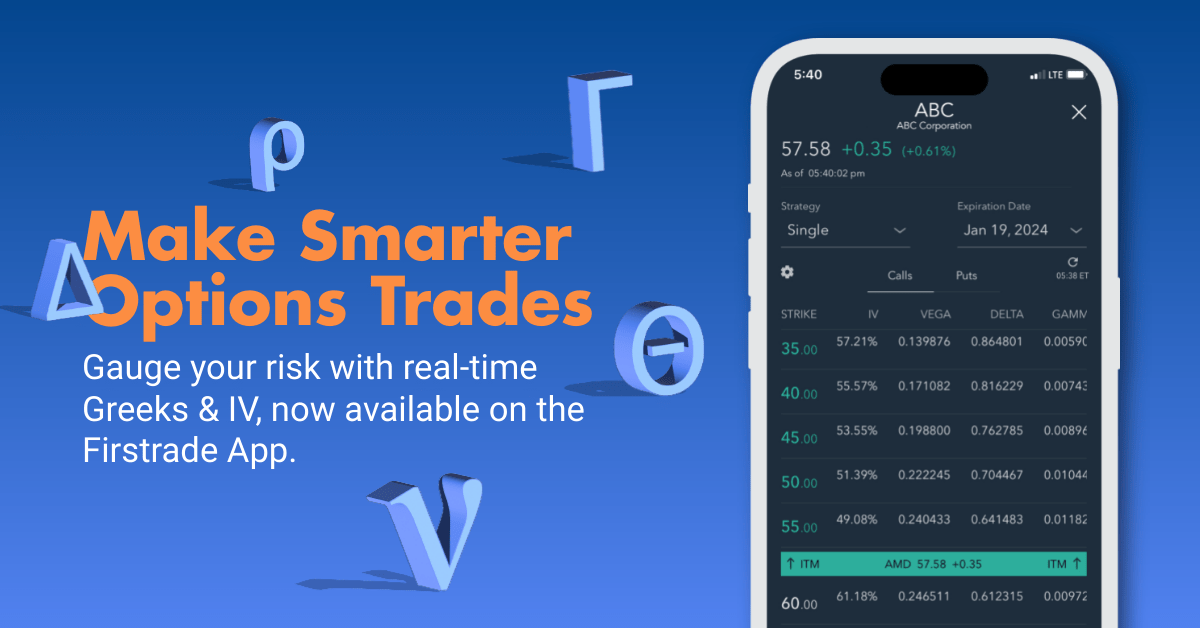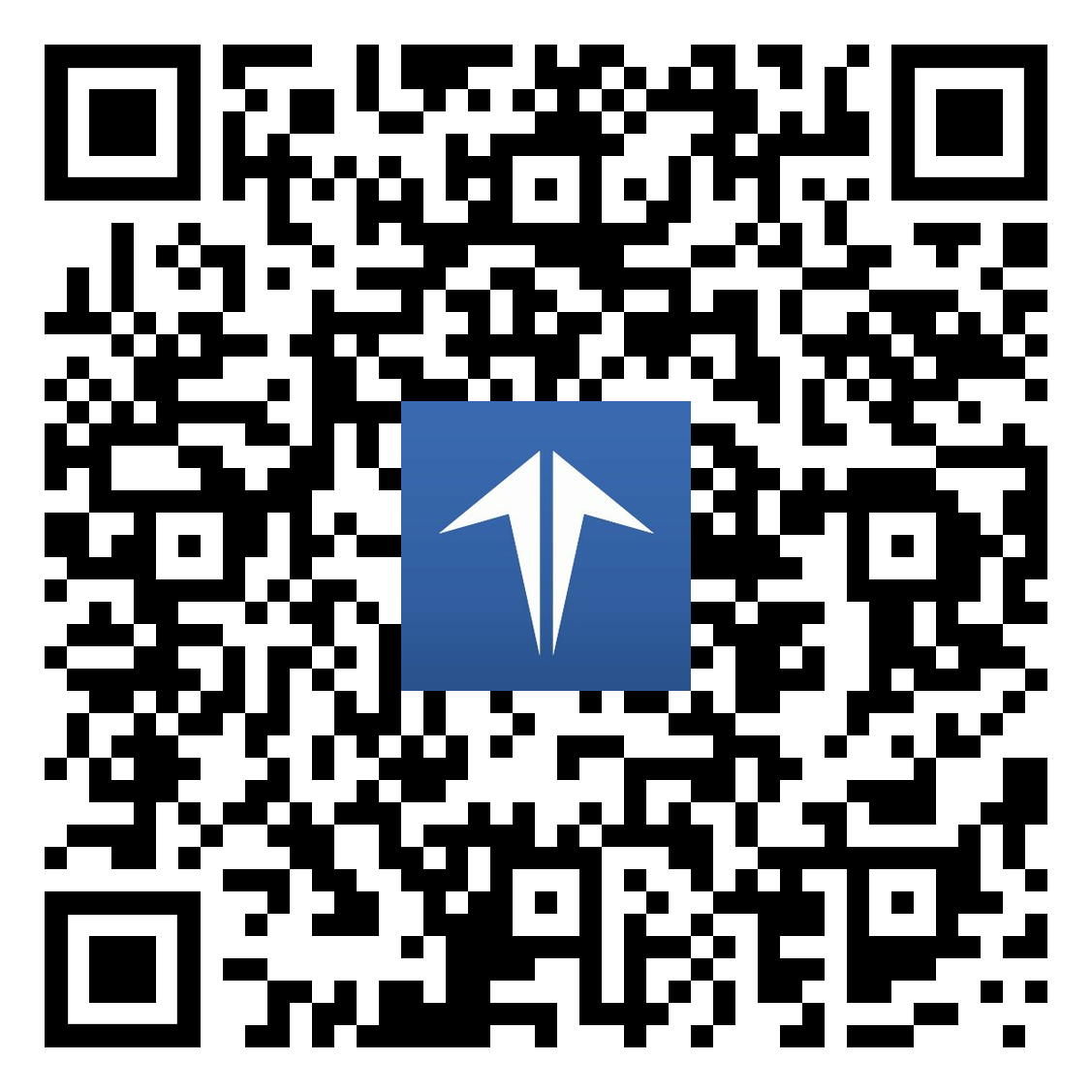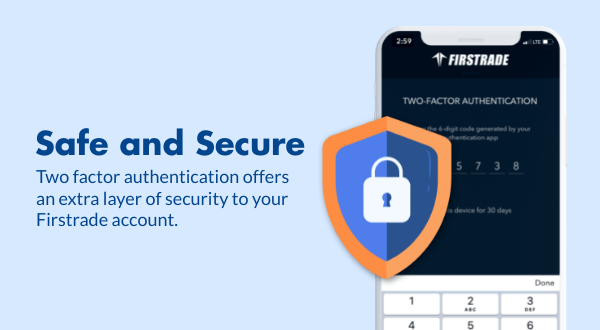
Level Up your Options Trading
Today we added Greeks and Implied Volatility (IV) to the option chain on the Firstrade app — this important update will help you quantify the different factors that might affect the price of your option trades before you place an order.
Today we added Greeks and Implied Volatility (IV) to the option chain on the Firstrade app — this important update will help you quantify the different factors that might affect the price of your option trades before you place an order.
Here are the highlights:
Option Greeks
Delta, Gamma, Theta, Vega and Rho calculations embedded in the app measure various factors that impact the price sensitivity of an options contract. This will help you make informed decisions about which options to trade, and when to trade them.
Implied Volatility (IV)
View the IV on the options chain to see the market’s forecast of a likely movement in the underlying security.
These new features are now available on both the Firstrade desktop platform and the latest version of the app. Join our weekly webcasts and access our free educational videos to improve your options trading knowledge.
Delivering the best experience for investors is our top priority as we provide industry-best pricing with $0 commission trades and $0 contract fees for options trades.
Options trading involves risk and is not suitable for all investors. Options trading privileges are subject to Firstrade review and approval. Please review the Characteristics and Risks of Standardized Options brochure and the Supplement before you begin trading options.
iOS App dowload
Android App download
Two Factor Authentication (2FA) Now Available On Mobile
Two Factor Authentication (2FA) is now available across all devices, after the successful rollout of fully-integrated mobile protection. Once enabled, customers will now be required to enter 2FA codes each and every time they login, except after choosing to “trust this device for 30 days”. The integration comes at a relevant time, in the midst of Cyber Security Awareness Month.
Two Factor Authentication (2FA) is now available across all devices, after the successful rollout of fully-integrated mobile protection. Once enabled, customers will now be required to enter 2FA codes each and every time they login, except after choosing to “trust this device for 30 days”. The integration comes at a relevant time, in the midst of Cyber Security Awareness Month.
During a time in which phishing attacks and cyber scams are on the rise, additional security for Firstrade customers is a priority. The Mobile 2FA deployment now complements existing desktop protection, ensuring that customers have the highest level of protection across all devices that utilize Firstrade apps and services.
What is Two Factor Authentication?
2FA is one of the best methods of defense against threat actors. Enabling 2FA provides an extra layer of protection outside of standard password and pin entry, with the need to enter a 6-digit code in real-time becoming a mandatory requirement to each and every login.
After password entry, customers will be required to enter one of the randomly generated 2FA codes, that change every 20 seconds. This ensures that codes are entered in real time, and are entered by a genuine customer and holder of the account.
A few 2FA apps that are compatible with Firstrade are:
Google Authenticator for iPhone and Android.
Microsoft Authenticator for iPhone and Android.
How To Set Up Two Factor Authentication on Firstrade?
On Mobile:
Login to your Firstrade account on your chosen mobile device.
Go to Account.
Go to App Settings.
Toggle Two Factor Authentication to on and off.
Follow the on-screen instructions to complete 2FA setup.
On Desktop:
Login to your Firstrade account on a Desktop device.
Go to Accounts > Profile and click on the Login/PIN tab.
Under Two Factor Authentication, click Turn on 2FA.
Enter your Firstrade password for confirmation.
Open your chosen authentication app on your device and scan the QR Code.
Enter the 6-digit authenticator code generated by your app.
Follow the on-screen instructions to complete 2FA setup.
It is strongly encouraged that you save your backup code in a secure place, in the event you lose your device or are unable to access your authentication app.
You can write down the backup code and store it securely, or store it in a protected folder.
Secure Your Device Today!
Setup Two Factor Authentication today, and increase your account security.
Useful Links:
Two Factor Authentication - Help Center
Scan to download iOS app
Scan to download Android app
Firstrade Launches Cash Bonus Awards For New Customer Deposits
Firstrade is pleased to announce the launch of a Cash Bonus award, payable to all new accounts that open and fund an account during the award phase. New account deposits will accrue a bonus depending on amount deposited, up to and including November 10th.
But what is the eligibility criteria, and what does it mean for you?
Let’s dive in.
Firstrade is pleased to announce the launch of a Cash Bonus award, payable to all new accounts that open and fund an account during the award phase. New account deposits will accrue a bonus depending on amount deposited, up to and including November 10th.
But what is the eligibility criteria, and what does it mean for you?
Let’s dive in.
Cash Bonus: How Does It Work?
Despite somewhat bearish market conditions, Firstrade continues to double down on new accounts and growth, by rewarding new customers with additional bonuses just for depositing to a new account.
The offer is also available to new accounts that transfer to Firstrade from other brokerages, plus up to $200 being made available to transferring customers to cover transfer fees upon joining Firstrade - in addition to any awarded cash bonus amount.
The Cash Bonus offer provides customers with rewards tiers depending on the amount deposited to individual, joint or custodial brokerage accounts - with individual retirement accounts (IRAs) also being eligible. Cashback amounts vary from $50 cashback for $5,000 deposits, up to $4,000 cashback for deposits of $1,500,000+, with a range of tiers in between depending on the amount. Deposits to accounts can then be used for interoperable trading across a suite of investment products including; Stocks, ETFs, and Options.
Bonuses can also be used to trade crypto through new individual brokerage accounts that have been credited with a qualifying deposit.
The bonus tiers and required deposit amounts are as follows:
How to get a new account bonus with Firstrade:
Open an account using the Open Account tile on the Firstrade homepage.
Complete ID&V by submitting requested documents in order to verify your account.
Upon acceptance of your ID documents, login to your new Individual Brokerage Account or Retirement Account.
Deposit funds into your newly-created account, with a minimum $5,000 deposit amount being required to earn a bonus.
Use your Firstrade account within the terms and conditions to keep your bonus.
Why Open An Account With Firstrade?
New and existing customers are able to access powerful Firstrade desktop and mobile apps and access $0 commission trading in just a few clicks. Options trades are available at a market-leading price of $0 per contract, usurping some of the industry’s leading brokerages in terms of trading competitiveness.
Trading is also offered without exchange, exercise, or assignment fees, with traders also being equipped with a plethora of resources from the likes of Morningstar, OptionsPlay and Zacks to help through investment journey’s regardless of skill set or experience.
About Firstrade
Firstrade is a top-rated online brokerage, offering customers a suite of investment products, no-fee IRA retirement services and advanced tools to help self-directed investors take control of their financial future, while having the lowest average cost among other brokerages. Since 1985, Firstrade has been a member of the Securities and Exchange Commission (SEC), the Financial Industry Regulatory Authority (FINRA) and the Securities Investor Protection Corporation (SIPC). For more information, https://firstrade.com.
Cryptocurrency trading is offered by Apex Crypto LLC. Cryptocurrencies are not securities and are not FDIC or SIPC insured. Cryptocurrency execution and custody services are provided by Apex Crypto LLC (NMLS ID 1828849) through a software licensing agreement between Apex Crypto LLC and Firstrade Crypto LLC. Please understand the risks before trading: apexcrypto.com/legal.
Firstrade is available on Desktop, or to download on iOS and Android.
Scan to download iOS app
Scan to download Android app
Top 25 Most Traded Stocks & ETFs by Investors at Firstrade in September
Get the full list of top favored stocks and ETFs among Firstrade investors in the last month.
Here’s the full list of top favored stocks and ETFs among Firstrade investors in the last month:
ProShares UltraPro Short QQQ ETF (SQQQ)
ProShares UltraPro QQQ (TQQQ)
Tesla Inc. (TSLA)
Apple Inc. (AAPL)
NVIDIA Corporation (NVDA)
Direxion Daily Semiconductor Bull 3X Shares (SOXL)
Advanced Micro Devices, Inc. (AMD)
Invesco QQQ Trust Series 1 (QQQ)
Vanguard 500 Index Fund ETF (VOO)
Direxion Daily Semiconductor Bear 3X Shares (SOXS)
Taiwan Semiconductor Mfg. Co. Ltd. (TSM)
Vanguard Total Stock Market Index Fund ETF (VTI)
Amazon.com, Inc. (AMZN)
Microsoft Corporation (MSFT)
ProShares Ultra VIX Short Term Futures ETF (UVXY)
SPDR S&P 500 ETF Trust (SPY)
Alphabet Inc Class A (GOOGL)
Alphabet Inc Class C (GOOG)
Vanguard Total World Stock Index Fund ETF (VT)
Occidental Petroleum Corporation (OXY)
Direxion Daily S&P Biotech Bull 3X Shares ETF (LABU)
Meta Platforms Inc. (META)
ProShares UltraPro Short S&P500 (SPXU)
Bank of America Corp (BAC)
Carnival Corp (CCL)
Top 25 Most Traded Stocks & ETFs by Investors at Firstrade in August
Get the full list of top favored stocks and ETFs among Firstrade investors in the last month.
Here’s the full list of top favored stocks and ETFs among Firstrade investors in the last month:
Tesla Inc. (TSLA)
ProShares UltraPro Short QQQ ETF (SQQQ)
ProShares UltraPro QQQ (TQQQ)
NVIDIA Corporation (NVDA)
Apple Inc. (AAPL)
Advanced Micro Devices, Inc. (AMD)
Direxion Daily Semiconductor Bull 3X Shares (SOXL)
Invesco QQQ Trust Series 1 (QQQ)
Taiwan Semiconductor Mfg. Co. Ltd. (TSM)
Direxion Daily Semiconductor Bear 3X Shares (SOXS)
Amazon.com, Inc. (AMZN)
Vanguard 500 Index Fund ETF (VOO)
ProShares Ultra VIX Short Term Futures ETF (UVXY)
Palantir Technologies Inc. (PLTR)
AMC Entertainment Holdings Inc. (AMC)
ProShares UltraShort Bloomberg Crude Oil (SCO)
Vanguard Total Stock Market Index Fund ETF (VTI)
Microsoft Corporation (MSFT)
Alphabet Inc Class C (GOOG)
Alphabet Inc Class A (GOOGL)
Bed Bath & Beyond Inc (BBBY)
Occidental Petroleum Corporation (OXY)
Meta Platforms Inc. (META)
Bank of America Corp (BAC)
Intel Corp (INTC)











